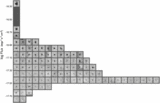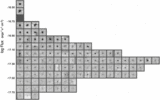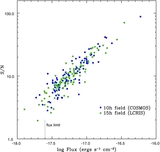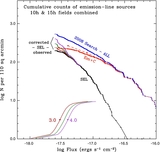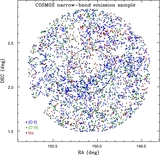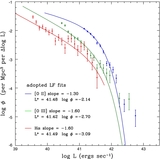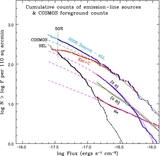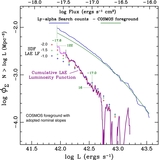Image Details

Caption: Figure 6.
Angular cross-correlation function ω(θ) between SEL sources found in our 2008 search of the 10h field and the COSMOS narrow-band detections of galaxies with [O ii] emission at z ≈ 1.19 over the full IMACS field. The dashed green line shows a very strong correlation between 33 bright SEL sources ( F > 7.5 × 10 −18 erg s −1 cm −2) and foreground [O ii] emitters, however, the strong signal in the first bin is due to the fact that six of these bright SEL sources are certain or probable H ii regions in galaxies in the [O ii] sample. However, even without these, the correlation function for the bright sample—the blue line—is still strong, a 4σ or greater difference from "random." In contrast, the red line shows that the 70 faint SEL sources ( F < 7.5 × 10 −18 erg s −1 cm −2) are uncorrelated with the foreground [O ii] emitters, suggesting the latter make up half or less of this population. Monte Carlo models show this result to be very significant as well, although the unavailability of a foreground population as faint as our sample prevents a good constraint on how big the foreground contribution can be. This decline in amplitude of the cross-correlation function with decreasing flux suggests that the steep rise in SEL sources is the result of a large population of LAEs at z = 5.7.
Copyright and Terms & Conditions
© 2011. The American Astronomical Society. All rights reserved.


